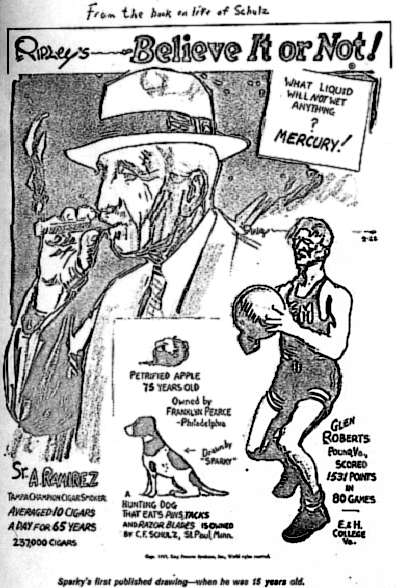Glenn Roberts High Scorer
|
|
||||||||||||||||||||||||||||||||||||||||||||||||||||||
|
The first commercial drawing of Charles Schulz of Peanuts fame was this cartoon sketch in the Ripley's Believe It or Not. Glenn Roberts, Pound VA, scored 1531 Points in 80 Games at Emory and Henry College, VA. (c. 1936) |
||||||||||||||||||||||||||||||||||||||||||||||||||||||
|
Pound Virginia's Glenn Roberts High Scorer |
||||||||||||||||||||||||||||||||||||||||||||||||||||||
|
Glenn Roberts' high school and college scoring was considered by many nothing short of spectacular. Compared to today, record keeping in the 1930s was very lacking and it is therefore impossible to give an accurate accounting of his high school scoring totals. Testimony from former high school teammates, via letters submitted to the National Basketball Hall of Fame, indicate that Roberts’ high school scoring was well in excess of a 20 point average. Many considered his college scoring as truly “unbelievable as Ripley's Believe it or Not feature indicated. His 2,013 point total stood unmatched until 1949 when Loyola’s Steve Lacey exceeded 2,000 points. The closest that any college player, prior to 1935, had come to Glenn Roberts’ 19 plus per game average was “Hall of Fame” great and 1930 Montana State graduate, John "Cat" Thompson, with a 15 plus per game average. Nineteen, of the 100 games Thompson’s team played during his four years, was against non-college opponents with Montana State averaging 77 points per game and winning each game. (Example: Montana State beat Havre All-Stars – 110 to 10). It is therefore obvious that Thompson averaged significantly less than 15 points against bona-fide college teams. |
||||||||||||||||||||||||||||||||||||||||||||||||||||||
Glenn Roberts' and Hank Luisetti's Records |
||||||||||||||||||||||||||||||||||||||||||||||||||||||
|
In 1938, newspapers throughout the South announced that Stanford's great “Hall of Famer," Hank Luisetti, voted 2nd greatest player of the first half century, had broken Glenn Roberts’ scoring record. They stated that Luisetti had scored 1,596 points in four years as opposed to Roberts’ 1,531 points. What was overlooked by the press was the fact that 305 of Luisetti’s points were scored in 15 games as a freshman against college freshmen and high school teams. It was also in his freshman year that Luisetti attained his highest average (20.3) of any of his four years at Stanford. Also, Hank Luisetti played in 95 games (compared to Roberts' 80 games) in accumulating his 1,596 points for an overall per game average of 16.8 points. In a letter dated April 27, 1979 and addressed to Carroll Tate of The Coalfied Progress, Stanford University’s “Sports Information Director,” Bob Rose, confirms that Luisetti’s scoring total was 1,291 points in 80 games for a 16.1 per game average (sophomore, junior and senior years). Glenn Roberts played all 80 games against varsity college competition, including 18 games as a freshman. During his freshman year, Roberts scored 292 points for an average of 16.2 points per game. Note the following comparison chart summarizing Roberts’ and Luisetti’s college statistics for games played against college teams. |
||||||||||||||||||||||||||||||||||||||||||||||||||||||
|
||||||||||||||||||||||||||||||||||||||||||||||||||||||
|
There are several glaring similarities between Roberts’ and Luisetti’s basketball careers. First, both used a revolutionary new shot that accounted for each players’ accelerated scoring – Roberts with a two-handed jump shot and Luisetti with a one-handed running shot. Secondly, the team records for Emory and Henry and Stanford were 68-12 during Roberts’ and Luisetti’s 80 varsity games played against other colleges and universities. Thirdly, Roberts and Luisetti each scored fifty points in a game – Roberts against the "House of David," a non-college team. (Roberts scored 38 points in a college game against Union College of Kentucky]] Luisetti's 50 point performance was against Duquesne University of Pennsylvania. Lastly, both Roberts and Luisetti enjoyed a limited post-college professional basketball career. Luisetti's rise to national prominence was generated by Stanford's good fortune in being invited by Ned Irish to play in Madison Square Garden. After barnstorming across the country playing to capacity crowds in big cities like Cleveland and Philadelphia, Stanford concluded their tour by playing Long Island University (LIU) on Dec. 30, 1936. LIU had won 43 straight games, but was whipped by Stanford as Luisetti had a great night scoring 15 points. One can only conjecture the result had Emory and Henry and Glenn Roberts been invited by Ned Irish to play in Madison Square Garden. Would the opposing teams have been able to adjust to and defend the unorthodox and likely never-before-seen two handed jump shot of Glenn Roberts? On the other hand, how well would Luisetti's exploits have been remembered had Stanford not made their cross-country trip culminating in the LIU game where he was in the cross-hairs of the powerful Northeast press. A comparison of Roberts’ and Luisetti’s playing abilities is not the intent here, nor is it an attempt to detract from Luisetti’s greatness. It is intended, rather, to use Luisetti’s great accomplishments as a mirror for Glenn Roberts’ individual basketball accomplishments. Record keeping was also limited in college games of the 1930s and therefore records for field goal percentages, foul shooting percentages, assists etc. were non-existent. Letters from Emory and Henry teammates Sam Neal, Walter Fielder and Paul Mackey, on file at the Naismith Basketball Hall of Fame, indicate that Roberts field goal percentage was well in excess of 50 per cent. They further state that he rarely missed a foul shot. They also attested to his strong defensive play. Roberts, in a 1975 interview with Abe Goldblatt for his book, "The Great and the Near Great: A Century of Sports in Virginia," stated that he "took every defensive assignment as a personal challenge to hold my opponent to as few points as possible." Also, in a letter on file at the Basketball Hall of Fame, Firestone teammate Irv Terjesen testifies to Roberts' all around play. If one is to believe the testimony of his college and professional teammates, Roberts was more than a prolific scorer, but an all around great player. Newspaper Clippings from various newspapers and over 100 letters from teammates, opponents, coaches, referees and sportswriters are on file at Basketball Hall of Fame. |


















